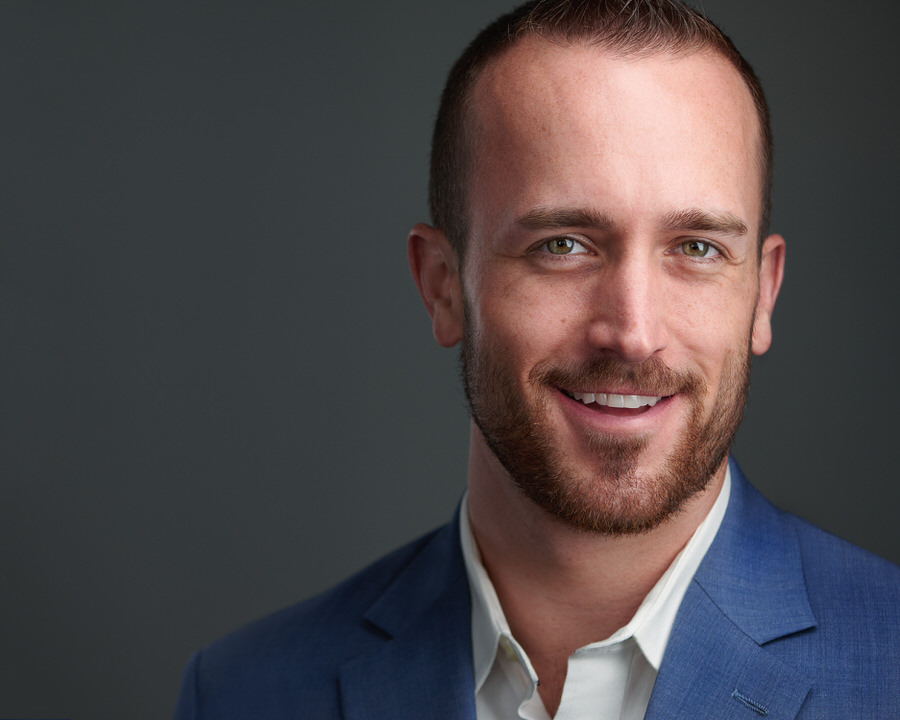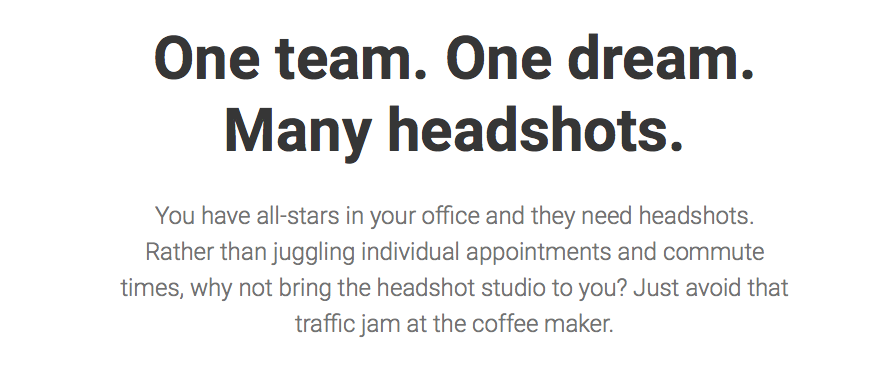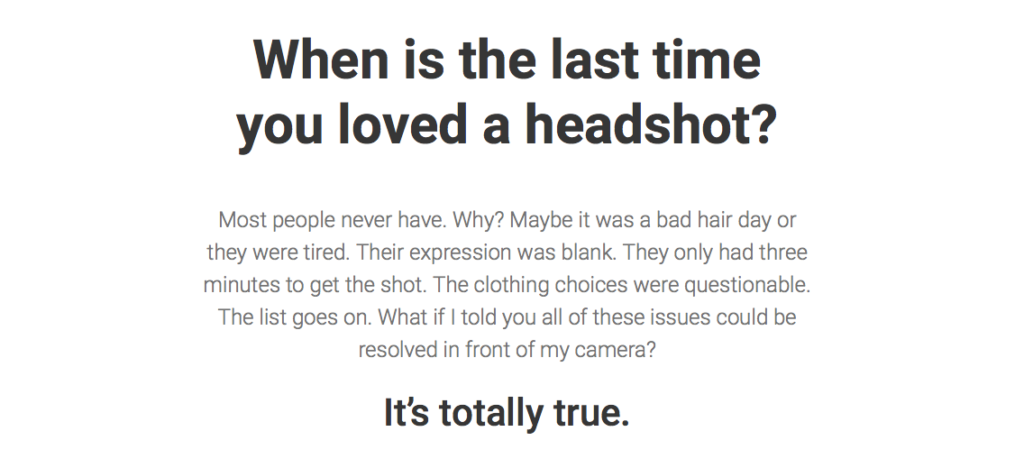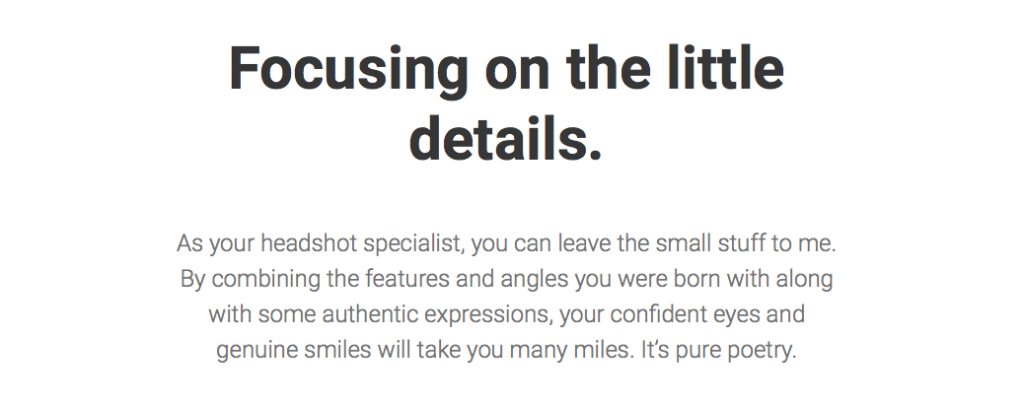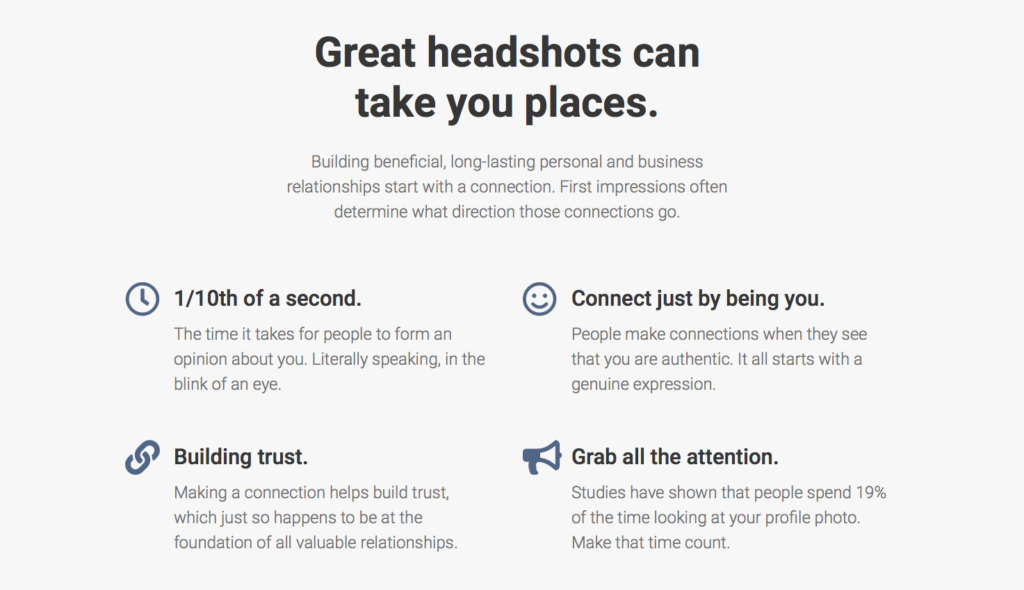What You Can Learn From My Website Redesign Journey
After four months of laborious work, I put together the perfect website. It had every element that would translate to business, from the hero image at the top to smart headlines and convincing copy. I couldn’t wait to show it off because I confidently believed it was one of the best headshot photography websites out there.
There was only one problem. It was utterly uninspiring; so much so, that eight months later I got grossed out reading it and immediately gutted it to the studs. My perfect home(page) remodel was nothing more than an uninformed clunker that offered no emotional value. It was time to change my perspective and think from a potential client’s point of view. I hope this year-long journey in roughly 1,300 words will help guide you so that your website is able to bear sweeter fruit faster.
THE PROBLEMS
Where do I even start? First, above the fold (an old newspaper term detailing what content was – wait for it – above the fold) was a headline telling the viewer they needed to work with a headshot photographer because we notice all of the tiny details. A true statement indeed, but who wants to be told what to do? Second, because I felt the headline wasn’t enough, I listed all of those little details. Captain Obvious type stuff. The only emotion I was tapping into was disgust and the frantic search for the back button.
To pile on further, my text wasn’t pulling its weight when it came to search engine rankings. My copy was so broad and unfocused that I didn’t utilize any of the keywords people might use to search and find me. As a result, I was only hitting page 5 or 6 in search results. One might know that page 5 on Google is where the world’s best-kept secrets lie.
Try JPEGmini Pro For Free Now!
A MODERN, OPEN-CONCEPT UPGRADE
It wasn’t until after a series of eye-opening conversations with two close friends in the industry that I decided to make an honest change to my website copy. John DeMato, a lifestyle photographer and content creator out of New York City, and Jason Ranalli, a fellow headshot photographer out of the Philadelphia area, both helped me realize it was time to speak directly to my target client with smarter, more nimble copy that discussed pain points and solutions. It was time to stop attempting to entice an entire ballpark. Furthermore, I took a Headshot Sales and Marketing course by Chicago headshot and portrait photographer Mike Schacht to help me refine this idea further.
IT’S LIKE HE’S READING MY MIND
A pain point is basically the complaint someone has about a problem they need help solving. In headshots, a common pain point is they hate getting a headshot. No small hurdle to overcome. Even though I love my job, that positive internal energy wasn’t translating to them on my website, and people would show up anxious or nervous. I began searching out the many issues people had with headshots and went to work introducing real-world solutions.
I recall reading somewhere that a common advertising practice is to read online reviews (such as Amazon) to learn what people are looking for, or not, in a product or service. It’s a great way to see how you can speak their language. Those types of reviews wouldn’t help me, so I turned to the next best thing: LinkedIn ProFinder requests.
I’d been an avid user of ProFinder for quite some time, with decent success. Little did I realize that each request that came in was packed with pain points. People have the option to comment on their submission, such as what they’ll be using their new headshot for and things of that sort. Once my level of awareness recognized this, I began listing them out, one by one, and ranking them in order of frequency or importance.
This opened up a whole new world for me. My perspective immediately changed. I went from telling people why they needed to work with me to the real heartfelt reason why I was in headshot photography in the first place: I made it all about them and their experience. I was going to help solve their problems by offering a smooth, fun path to getting a headshot that they would be excited to use. They’ll get an experience that’s so fantastic that they will never forget it.
SAY MORE WITH LESS
Once I learned how to write from the heart, my own pain points began to melt away. For instance:
– I went from writing a meandering mess of ballooned text (a.k.a. Research Paper Syndrome) to delicious bite-sized morsels of information, often in 140 characters or less.
– I developed a style and tone that is used on everything I put out in the world. It’s lightweight, fun and whimsical.
– It taps into people’s emotions and gets them to feel excited and informed without it seeming like a chore.
– Instead of ‘writing for everyone and speaking to nobody,’ I spoke directly to the dream client I love collaborating with.
– Best of all, people now show up to their sessions excited to go through an excellent headshot experience. My website put them at ease before we even began talking.
SIMPLIFY
Another area this helped me to focus was the design of my website. By writing less, I was able to get more creative with text placement. Paragraphs of info were now single sentences that were direct and memorable.
I dumped cheesy design elements that did nothing to enhance my content by opting for white space. It’s hard enough to read and comprehend this stuff sometimes. Give eyes a place to rest.
An internal linking structure was put in place that gives viewers easy ways to click around to learn more about my other services. More on this in a moment.
With smaller sections on my homepage, I could pepper in many calls-to-action (CTAs) such as links to scheduling information, contact forms or downloading headshot tips. Keep reading because I have more on this, too.
SEO
Ah, yes, search engine optimization. The stuff we go to bed dreaming about, or not. Regardless of your personal opinion on the subject, SEO is incredibly vital through the website-building process and beyond. Optimizing never stops. A few tips I learned along the way should be shared:
1. Internal linking structure. Search engines love it when they notice people hanging out for a while on your website, scrolling and clicking around. Placing clear, descriptive links in critical spots to support your other content will keep people from making a quick U-turn to another website. Make learning about you and your business simple.
2. Calls-to-action. Giving your visitors multiple areas to interact with you, whether it’s scheduling a session or consultation, asking for more info, or downloading free content, creates a more accessible path to a booking. Search engines also enjoy seeing visitors interacting with your content.
3. Keywords. Write your content so that it includes key terms (in an organic, natural way) that people might use to search for you. You better believe I have ‘Boston headshots’ and ‘headshot photographer in Boston’ worked into my tightened copy. Just a reminder though, use the terms in a naturally spoken form. Shoehorning words will only confuse your readers and upset search engines.
PUTTING A BOW ON THIS
When the fine folks at JPEGmini approached me about a guest blog, I wanted to use this opportunity to help people remember one thing when it comes to website design and copy: simplify. What I once thought was incredible ended up burying my website in the sewer system of search results. It’s been a constant series of tweaks since my reboot, and that’s perfectly okay because I have a great foundation in place.
You can avoid going down the same awful path by keeping these key points in mind:
1. Find your inner voice and write in it.
2. Discover people’s pain points and the solutions you offer.
3. Define your ideal client and write to their emotions.
4. Simplify by being concise with your text and design.
5. Make it easy to learn about your services on your website.
6. Give visitors easy access to calls-to-action.
7. Write your site with search in mind, naturally.
Here’s to you, your craft, and a website that works for you day after day, month after month, year after year. With constant tweaking and refinement, of course.


